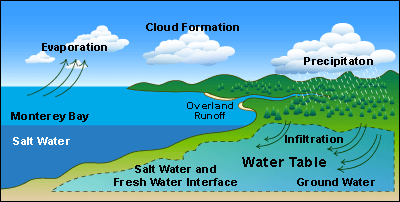Water, one of earths most precious resources, exists in several forms in the environment including sea water, sea-ice, fresh water, and water vapor as clouds and mist. As it moves through the environment it picks up gasses and elements, flows to the sea and through ground, in an endless process known as the hydrologic cycle.
Studying the concept of the hydrologic cycle is perhaps the most useful way to understand how precious fresh water is, and how important the health of the oceans are to sustain life on the planet. The term ‘hydrologic cycle” refers to the day-to-day and long term changes in the hydrosphere. The cycle may be viewed as a description of the ways in which water moves around the earth. It is important because it accounts for the circulation of water in all the different states. Planners may use the hydrologic cycle as a conceptual tool in order to anticipate problems and consequences which may arise from development. Students typically study the hydrologic cycle in high school.
The distribution of water is the key to understanding the hydrologic cycle as well as the availability of water for human use or consumption. The current distribution is as follows:
Percentage of Water Location/Form
97.200% salt water in the oceans
02.014% ice caps and glaciers
00.600% groundwater
00.009% surface water
00.005% soil moisture
00.001% atmospheric moisture
Of this distribution, the two sources of available freshwater consist of groundwater and surface water. Therefore, approximately 98% of the available freshwater is in the form of groundwater while the remaining 2% is in the form of surface water.
As seen in the schematic above, the hydrologic cycle is the continuous circulation of water from the ocean to the atmosphere to the earth and back to the ocean. This cycle is solar powered as the water from the ocean and the land surface evaporates to the atmosphere. Throughout the cycle, water may be temporarily stored in lakes, streams, the soil, as groundwater, etc.
The amount of water on the Earth is calculated using a mathematical equation. The equation considers the amount of water that comes into a liquid state, versus the amount of water that is available as vapor in rain or clouds etc. In the hydrologic equation, there is always the same amount of water, but some of the water is found as rain, clouds, ice, and in a liquid state either on the surface of the Earth or in the ground.







